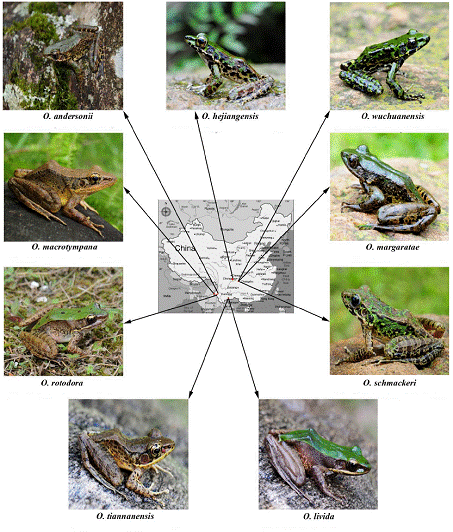Odorous frogs are been famous thanks to their specialty of producing skin secretions with unpleasant smellswhen they are stimulated. And they also take the pivotal spot on the road of amphibian evolution as they are the important transitional type from rana to hylarana of ranid. Among the 20 odorous frog species worldwide, 13 could be found in China. This advantage facilitated the Dr. ZHANG Yun (Kunming Institute of Zoology, the CAS) and his colleagues’ investigation on the antimicrobial peptides (AMPs) from the odorous frogs’ skin secretions.
Bacterial resistance to current antibiotic drugs is a threat to human beings all overthe world. There is a considerable interest in the development of antimicrobial agentsas a novel therapeutic approach to treat infections.The natural AMPs from amphibian skin secretions have been considered as the excellent templates for the design of novel antibiotic, owing totheir unique mechanism which differs from the conventional clinical drugs.
During the past two years, 9 Chinese odorous frogs have been collected from Sichuan, Yunnan and Guizhou Province, and their skin secretions have been systematic analyzed. Among the 728 AMPs which were indentified from the skin secretions of these 9 Chinese odorous frogs, 662 were novel. Based on the sequence similarity of deduced mature peptides, these 728AMPs were grouped into 97 different families in which 71 novel families wereidentified. The purified peptides showed strongantimicrobial activities against 4 tested microbe strains. Twenty-three deduced peptides weresynthesized and their bioactivities, including antimicrobial, antioxidant, hemolytic,immunomodulatory and insulin-releasing activities, were evaluated. These findings impliedodorous frogs might represent the most extreme AMP diversity in nature and provided numerous amount templates information for novel antibiotics designing.
Besides, the results clearly demonstrated that 21 identical AMP moleculesrepresented by 28 repeated molecules could distribute in at least 2 different frogspecies of present studied 9 odorous frogs. Meanwhile, 28 present identicalAMPs represented by 38 repeated molecules were found to be existed in otheramphibian species. These findings questioned the generally accepted conclusion that the diversity of amphibian AMPs made itrarely possible to find identical AMPs in two different species, even in those closelyrelated.
Moreover, there also have evidence showed that in addition to the direct microbicidal activity, AMPs may also have diverse andcommentary abilities to modulate the innate immune response which could be the new hope tocurrent anti-infective therapy.
In summary, Dr. ZHANG’s results revealed that different AMP might have various biological activities and the present findings strongly suggested that odorous frogs might represent the most extreme AMP diversity in nature.
For the details of this article, please visit: Journal of proteome research (http://pubs.acs.org/doi/abs/10.1021/pr200782u).

Photographs and collecting areas of 9 kinds of odorous frogs (figure from KIZ).
